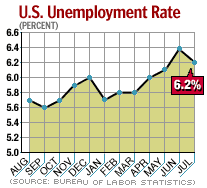NEW YORK (CNN/Money) -
After a slow summer for layoff announcements, the pink slips could start flying after Labor Day, according to a study released Tuesday by a layoff-tracking firm.
The weeks immediately following the Labor Day holiday are typically among the worst of the year for layoffs, said John Challenger, CEO of Chicago outplacement firm Challenger, Gray & Christmas, which publishes monthly reports of layoff announcements.

"You are 25 percent more likely to lose a job after Labor Day [Sept. 1] than in the preceding eight months," Challenger said. "The reasons: employers are finalizing budgets and business plans for 2004, and payroll levels are heavily impacted by both."
According to Challenger's research, between 1995 and 2002, the number of job-cut announcements between September and December was 25 percent higher than the number of cuts between January and August.
In a pattern that's been matched so far this year, Challenger said, job-cut announcements are relatively high between January and April, slow down from May to August and then ramp up again in September.
Challenger claimed, however, that some of the sectors that have seen some of the worst job-cutting in recent years -- including telecommunications, industrial goods manufacturing, government and financial -- are now "ripe with job opportunities."
And it's important to note that Challenger is talking about layoff announcements, not the actual layoffs themselves, which tend to come more often in the first half of the year.
| Related stories
|

|
|
|
|
What's more, Challenger doesn't seasonally adjust his figures, so his report simply has the effect of letting economists know how to seasonally adjust layoff announcements in the next few months.
For example, if announcements in October match the level of announcements in August, when they should normally be rising, that could actually be a very good sign for the labor market.
"What he's saying is not necessarily in opposition to the idea that the labor market may be stabilizing, but he's raising a warning flag," said Joel Naroff, president and chief economist at Naroff Economic Advisors in Holland, Pa. "If we don't see layoffs get any worse, then they're actually getting a lot better -- that's critical information."
Non-farm payrolls are nearly 2.7 million jobs lighter than they were in March 2001, when economists at the National Bureau of Economic Research believe the latest recession began. Though the NBER said that recession ended in November 2001, job growth has been extremely slow in coming, undermining consumer confidence and threatening the economy's recovery.
Economists, however, have seen recent signs that the glut of job cuts earlier this year is near an end, and they hope increased economic growth will boost demand for labor in the next several months.

|

